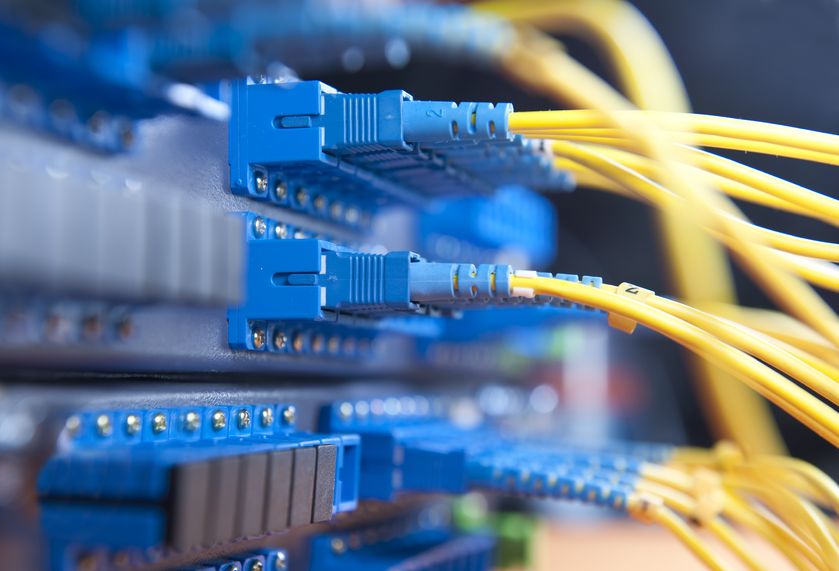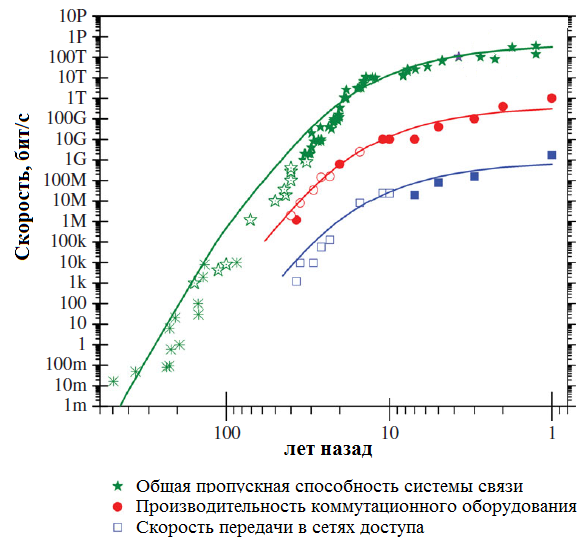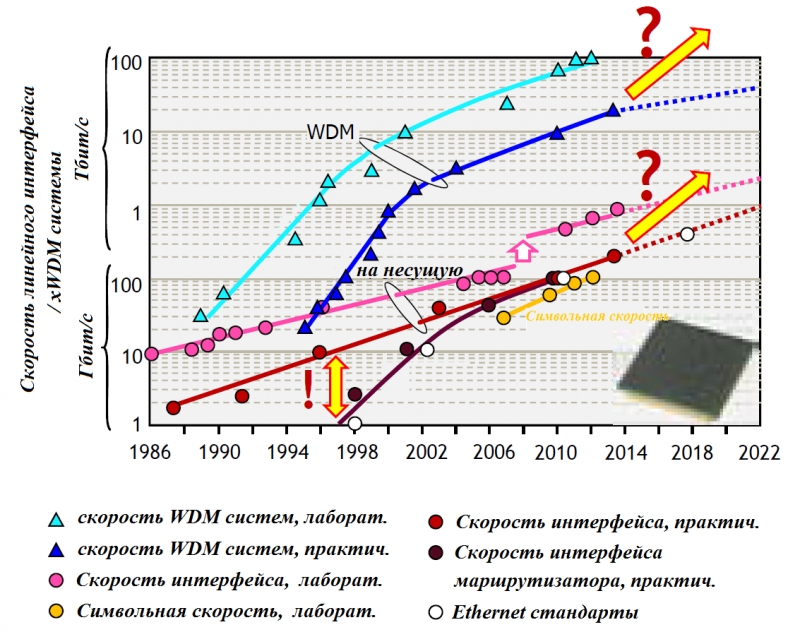
It can be figuratively said that today almost every phone call, every SMS sent, every video uploaded to youtube is at some point converted into elementary particles of light (photons) and carried at breakneck speed (over 200 thousand km / s) even along the bottom of the ocean through ultrathin glass filaments. Today, there are more than two billion kilometers of such threads involved; they can wrap the globe more than 50,000 times.
Now, if we talk about optical networks in a more serious language, the following can be noted. Until recently, the potential of standard single-mode fibers exceeded the level of throughput of optical networks necessary for solving the problem of traffic growth. Compared to attempts to develop a fundamentally new fiber platform, for a long time there were much more cost-effective ways to increase throughput. For a long time, these methods went hand in hand with the global growth rate of traffic and were implemented, for example, through a simple upgrade of terminal equipment in order to use the available bandwidth more efficiently. However, times are changing and today's laboratory experiments related to data transmission through standard single-mode fibers are getting closer to the fundamental limits of the throughput capacity of single-mode fibers. According to information theory, this limit for current fibers is estimated at about 100-200 Tbit / s. This fact raises concerns about the impossibility in the future of systematically increasing the network capacity at times and was called the “capacity crisis” of optical networks. To discuss the situation that has arisen, various symposia are already being arranged, they are trying to find solutions. Let's try to further explain the essence of this fact. For a better understanding, we first consider how the chronology of the growth rates of data transmission speeds on the globe, together with the evolution of the speeds of linear interfaces.
Features of the evolution of the speeds of communication systems and linear interfaces
The graph below shows the values of indicators characterizing the capacity of telecommunication systems over the past 500 years. In the general case, the communication system can be quantified by the value of the symbol rate and the amount of information per 1 symbol (number of bits per symbol). Green markers in fig. 1 shows the speed of the communication system in bits per second at a particular point in time.
Values of indicators characterizing the capacity of telecommunication systems over the past 500 years.
Fig. one

These results reflect the historical development of the capabilities of information transmission systems, starting from early communication systems, such as a set of relay towers, in which signals in the form of lighted lights were used to transmit messages from station to station. As is well known, in such first communication systems, the transfer of messages proceeded slowly, and they usually served to transmit an alarm signal. To transmit more complex messages, it was necessary to significantly improve performance by increasing the information content of each signal.
The crosses in the figure characterize the speeds of wireless communication systems, including such antediluvian ones, like the Murray optical telegraph and the Chapp brothers semaphore. As can be seen from the figure, at that early period an exponential increase in the transmission rate was observed, although the average annual growth rate was below 10%.
In the XIX century. electric signals began to be used to transmit messages, a telegraph appeared. The growth rate of productivity of communication systems has increased by about 20% per year. The use of electrical signals has significantly reduced the cost of operating communication lines by introducing electronic relay amplifiers instead of human-controlled relay towers. In the next 50 years, transatlantic cables were already constructed and soon the communication lines swept the entire globe, reaching the city of Adelaide in Australia in 1872.
Over the next century, copper-wire communication cables allowed to increase the capacity of networks, coaxial cables appeared. Various systems of multiplexing, modulation, etc. began to appear in communication systems. However, the capacity limit for such communication lines was about 1 Gbit / s. In addition, the combination of a large attenuation coefficient and a strongly limited channel band has become hard to limit the deployment of high-capacity systems. A new data transmission technology was needed - fiber optic lines appeared. Further development of networks, I think you can not describe. If someone is not familiar with the history of fiber optic links, but wants to know, you can read about it, for example, here.
In school history textbooks, it could be noted that the speed of commercial linear interfaces in optical transport systems, since the mid-80s, has steadily increased by about 20% per year. Owing to these rates, the volume of data transmission over a single fiber in the mid-1990s was already about tens of gigabits, which required the development of new technologies that increase the overall throughput of networks. The solution to the problem was the WDM system. Currently, network traffic is also growing at a rapid pace, annually increasing from 30% to 90%, depending on the type of traffic.
The following interesting points can be noted. Over the past decades, the performance growth of routers (due to the evolution of microprocessors and other computing devices in accordance with Moore's law) coincided with the rate of increase in traffic (see Figure 2). At the same time, the growth rate of the speed of high-speed optical interfaces was only 20%. Thus, we can note the following fact: the rate of growth in the performance of routers was faster than the growth rate of their interface speeds by about 40-60%.
Over the past decades, the performance growth of routers (due to the evolution of microprocessors and other computing devices in accordance with Moore's law) has coincided with the rate of increase in traffic.
Fig. 2 - Comparison of speeds of optical systems and speeds of linear interfaces

As can be seen from Figure 2, around 2005, the possibilities of optical linear interfaces began to limit the growth rate of the interfaces of the routers. Standardization of the 100G Ethernet interface and the 100 Gbps OTN transport module was implemented only in 2010, and standardization of the 400G Ethernet interface only in 2017. We can single out another consequence that arises from the disproportionate growth of electrical and optical interfaces — a reduction in the future level of aggregation of Ethernet flows into a single optical channel. That is, if previously a single 100G optical channel included ten component streams of 10GE, then with the standardization of the 100G Ethernet interface, this level of aggregation will no longer exist.
Today, the bandwidth growth rates of WDM transmission systems have slowed from 100% annual growth in the 1990s to only 20% per year. In 2010, commercial networks with WDM systems could support approximately 100 optical channels at 100 Gbps each. Thus, the throughput of one fiber reached 10 Tbit / s. With an annual traffic growth rate of 40%, we should expect that commercial systems will have to maintain a capacity of about 1 Pbit / s in 2024. This does not mean that by that time such systems will be fully utilized, which was not the case with the 2010 systems, but the commercial need to start installing such systems is likely to exist.
What follows from all the presented facts? Imagine that in your childhood at the age of 6 you could eat one apple and a small plate of porridge. In 10 years, we needed twice as much: two apples plus a portion of porridge grew 2 times. At 14, we already eat apples, a plate of porridge, a bowl of soup, plus we still need compote. Our appetite grows exponentially with time, and at 20 we eat like a sumo player, and at 32, like Robin Bobin Barabek (as in Marshak's poem). Thus, if at the very beginning our appetite was completely traditional and real for an ordinary person, then in the future, multiple growth rates led us to unimaginable volumes, which are difficult to implement in practice. The same situation occurs in modern optical networks.
The constant increase in the value of spectral efficiency in existing networks cannot continue indefinitely - there are limitations in the form of fundamental limits of channel capacity. The limitations are due to both technological imperfections of transmitters, receiving modules, multiplexers and optical amplifiers (internal noise of optical amplifiers), and the properties of the fiber itself (nonlinear effects). All this leads to different distortions of the signal and, accordingly, to practical limitations of the transmission rate. Recall that the fundamental limitation of the maximum transmission rate in a channel is called the Shannon limit - the physical limitation underlying the “capacity crisis” itself.
Today, the concepts of the crisis of the capacity of optical networks and the Shannon limit are widely used in the scientific community as a justification for the need to urgently develop innovative solutions. However, it should be noted that this term can be interpreted and interpreted in different ways. For example, in the oil exploration and production industry, the phrase “capacity crisis” or “capacity crisis” appeared much earlier and implied an approaching depletion of available resources. A common interpretation of this phrase means a limited, but still continuous supply of finite resources. In the same context, it is possible to refer to the “capacity crisis” as applied to optical networks. That is, in the future, a crisis of ability will mean the continued existence of optical communication networks that support most of modern society from an economic, administrative and social point of view, but with restrictions on the availability of network services.
It can be assumed that the “crisis of capacity” may lead to changes in the procedure for the calculation of network service providers. For example, consumers of services will pay operators for the actual bandwidth used. It can also be assumed that centuries after the creation of networks with higher bandwidth, network resources will finally meet our final desires, and traffic growth rates above 10% will be noted in history simply as a feature of the period of the end of the 20th century - first half of the 21st . However, judging by the emergence of new and new information applications, there is no sufficient evidence that demand is beginning to fill up. Nowadays, the “build it and it will come” approach prevails, i.e. first, new technologies are created, and then they are becoming popular with people. There are other proponents sticking to the “need to develop new as needed”. The latter believe that only with this kind of thinking will humanity fully develop and not drive itself, ultimately, into a dead end. On what approach society should develop, and with it telecommunication networks is a moot point; discussions on this issue are no longer young.
Prepared by Dmitry Kusaykin